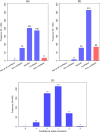Influences on improved confidence among allied health students in working with Australian Indigenous people during a rural placement: a pre-post survey study
- PMID: 39487488
- PMCID: PMC11529035
- DOI: 10.1186/s12909-024-06207-2
Influences on improved confidence among allied health students in working with Australian Indigenous people during a rural placement: a pre-post survey study
Abstract
Background: Together with addressing social determinants of health, culturally safe healthcare provision is essential for closing the health outcomes gap experienced by Aboriginal and Torres Strait Islander (Indigenous) Australians. Rural placements potentially provide students of the health professions with opportunities to enhance their knowledge and skills regarding cultural safety. We used rural placements data systematically collected from allied health students, including commencement- and end-of-placement questionnaire responses, to investigate the determinants of confidence in working with Indigenous people.
Methods: The study comprised data from all students who provided survey data at both commencement and end of their first placement directly supervised by the administering University Department of Rural Health during the period 2019-2022. Five-point ordered responses to the question 'How confident do you feel about working with Aboriginal people?' were used to assess student and placement-related determinants of confidence (Confident/Very confident versus other) at baseline and increased confidence (≥ 1 point) during the placement using crude and adjusted multivariable robust Poisson regression.
Results: Participating students (N = 489) were from diverse allied health disciplines (including pharmacy n = 94, 19.2%; chiropractic n= 66, 13.5%; physiotherapy n= 65, 13.3%; social work n = 59, 12.1%; and occupational therapy 58, 11.9%). Confidence in dealing with Aboriginal people was lower at commencement among females compared with males (adjusted relative risk [aRR] 0.65; 95% confidence interval [CI] 0.53-0.80), and higher among students of Australian rural origin compared with others (aRR 1.49; CI 1.22-1.83) and those who reported previous experience working with Indigenous people compared with those reporting none (aRR 1.40; CI 1.14-1.72). Placement attributes associated with increased confidence working with Indigenous people between placement commencement and end were interaction with Indigenous people within the placement (aRR 2.32; CI 1.24-4.34), placement model reflecting more structured academic supervision (aRR 1.18; CI 1.02-1.37), and placement length (aRR per additional day 1.002; CI 1.001-1.004). These associations were robust to modelling that accounted for a ceiling effect on increased confidence.
Conclusions: While influenced by students' demographic attributes and prior experiences, confidence of allied health students in working with Indigenous people is enhanced during rural placements, particularly through direct contact with Indigenous people.
Keywords: Allied health occupations; Australian Aboriginal and Torres Strait Islander Peoples; Education; Health workforce; Professional; Rural health services.
© 2024. The Author(s).
Conflict of interest statement
The authors declare no competing interests.
Figures


Similar articles
-
Students' experiences of placements in urban indigenous health contexts: developing a culturally responsive workforce.BMC Med Educ. 2024 Dec 18;24(1):1446. doi: 10.1186/s12909-024-06432-9. BMC Med Educ. 2024. PMID: 39696185 Free PMC article.
-
Determining health professional students' self-perceived cultural capability following participation in clinical placement with Aboriginal and Torres Strait Islander Peoples: A systematic review.J Foot Ankle Res. 2024 Dec;17(4):e70017. doi: 10.1002/jfa2.70017. J Foot Ankle Res. 2024. PMID: 39654074 Free PMC article.
-
Up close and real: living and learning in a remote community builds students' cultural capabilities and understanding of health disparities.Int J Equity Health. 2017 Jul 6;16(1):119. doi: 10.1186/s12939-017-0615-x. Int J Equity Health. 2017. PMID: 28683808 Free PMC article.
-
Exploring first-year occupational therapy students' perspectives of an On-Country experience: A study from an Australian undergraduate program.Aust Occup Ther J. 2025 Jun;72(3):e70019. doi: 10.1111/1440-1630.70019. Aust Occup Ther J. 2025. PMID: 40301007 Free PMC article.
-
Challenges to student transition in allied health undergraduate education in the Australian rural and remote context: a synthesis of barriers and enablers.Rural Remote Health. 2015 Apr-Jun;15(2):3069. Epub 2015 Apr 27. Rural Remote Health. 2015. PMID: 25916254 Review.
Cited by
-
The Effect of Aged-Care Rural Clinical Placements on Health Student Self-Efficacy: A Mixed-Methods Evaluation.Aust J Rural Health. 2025 Aug;33(4):e70083. doi: 10.1111/ajr.70083. Aust J Rural Health. 2025. PMID: 40772564 Free PMC article.
-
How Australian Rural Health Academic Centres Contribute to Developing the Health Workforce to Improve Indigenous Health: A Focused Narrative Review.Healthcare (Basel). 2025 Aug 1;13(15):1888. doi: 10.3390/healthcare13151888. Healthcare (Basel). 2025. PMID: 40805921 Free PMC article. Review.
References
-
- Briggs D. Challenges for Health Systems: Australian Perspectives. Public Adm Policy. 2017;20:6–17.
-
- McGrail MR, Humphreys JS. Spatial access disparities to primary health care in rural and remote Australia. Geospat Health. 2015;10:138–43. - PubMed
-
- Australian Institute of Health and Welfare. Indigenous health and wellbeing. Commonwealth of Australia. 2022. https://www.aihw.gov.au/reports/australias-health/indigenous-health-and-.... Accessed 1 Mar 2024.
MeSH terms
LinkOut - more resources
Full Text Sources
Miscellaneous

